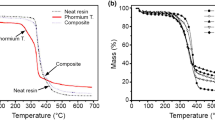Abstract
The results of an investigation of the physicomechanical properties of foreign (D.E.R. 330) and domestic (KhT-711) epoxy matrices, including those modified with polysulfone or polyetherimide, are presented. It is shown that the glass-transition point of epoxy compositions based on KhT-711 resin cured with iso-MTHPA can reach 190°C and exceeds the glass-transition points of the foreign binders by 15–30°C. The elastic moduli of the compositions based on KhT-711 resin are higher than those of the matrices based on D.E.R. 330 by 40–60%. All the investigated epoxy matrices exhibit seemingly high resistance to the action of acids, alkali, oil products, and water, whereas KhT-711 + iso-MTHPA + heat-resistant thermoplastic demonstrate a five to six times lower mass loss than do foreign matrices.
Similar content being viewed by others
References
V. A. Nelyub, “Determination of adhesion interaction between carbon fiber and epoxy binder,” Polym. Sci., Ser. D 8, 6–8 (2015).
V. A. Nelyub, A. S. Borodulin, A. S. Kobets, and G. V. Malysheva, “A study of structure formation in a binder depending on the surface microrelief of carbon fiber,” Polym. Sci., Ser. D 9, 286–289 (2016).
V. I. Solodilov, R. A. Korokhin, Yu. A. Gorbatkina, and A. M. Kuperman, “Comparison of fracture energies of epoxy-polysulfone matrices and unidirectional composites based on them,” Mech. Compos. Mater. 51 (2), 177–190 (2015).
R. A. Korokhin, V. I. Solodilov, Yu. A. Gorbatkina, and A. V. Shapagin, “Rheological and physicochemical properties of epoxy-polyetherimide compositions,” Mech. Compos. Mater. 51 (3), 313–320 (2015).
V. I. Solodilov, R. A. Korokhin, Yu. A. Gorbatkina, and A. M. Kuperman, “Organic fiber reinforced plastics based on complex hybrid matrices including polysulfone and carbon nanotubes as modifiers of epoxy resins,” Russ. J. Phys. Chem. B 6 (3), 425–432 (2012).
G. V. Malysheva, E. S. Akhmetova, and A. N. Marycheva, “Estimation of glass transition temperature of polysulfone-modified epoxy binders,” Glass Phys. Chem. 40 (5), 543–548 (2014).
N. I. Baurova, V. A. Zorin, and V. M. Prikhodko, “Description of scenarios of transition of material from an operable to inoperable state using an equation of fold catastrophe theory,” Polym. Sci., Ser. D 8, 1–5 (2015).
Author information
Authors and Affiliations
Corresponding author
Additional information
Original Russian Text © V.A. Nelyub, A.S. Borodulin, 2017, published in Klei, Germetiki, Tekhnologii, 2017, No. 9, pp. 7–12.
Rights and permissions
About this article
Cite this article
Nelyub, V.A., Borodulin, A.S. Properties of Epoxy Materials Used for Production of Glass-Reinforced Plastics by the Winding Method. Polym. Sci. Ser. D 11, 147–153 (2018). https://doi.org/10.1134/S1995421218020132
Received:
Published:
Issue Date:
DOI: https://doi.org/10.1134/S1995421218020132




